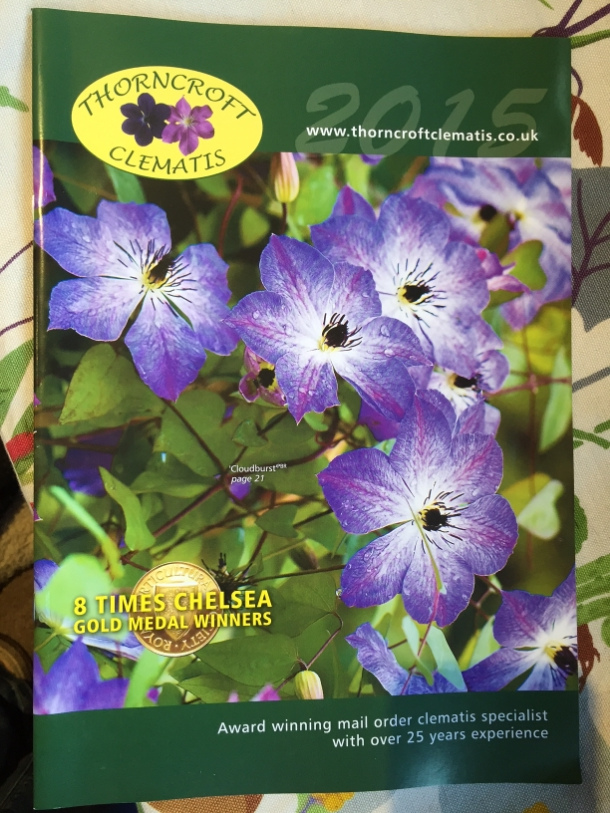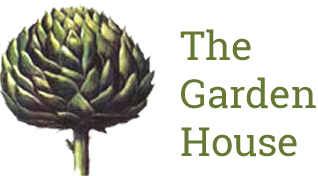In praise of Clematis – Pruning!
Posted:12 October 2015
We adore clematis in the garden, but sometimes find ourselves mystified by their different pruning and care regimes. People who are passionate about clematis (with good reason) say they are an easy and hugely useful and adaptable plant to grow, and this was highlighted so well by our excellent speaker, expert Peter Skeggs-Gooch, who popped in to the GH last Friday afternoon.
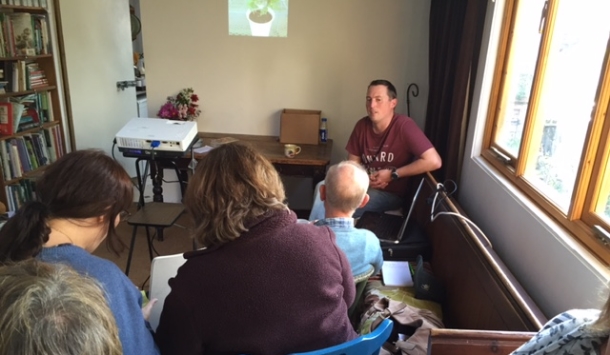
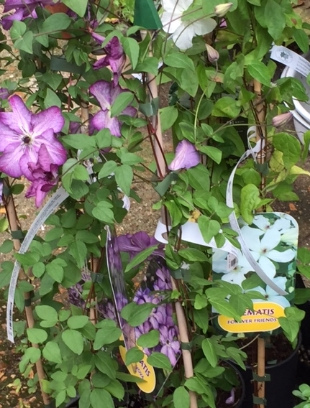 Peter owns Norfolk-based specialist nursery Thorncroft Nurseries, a third generation family business established in 1985, located in rural Norfolk and an Award Winning mail order clematis specialist with 8 Chelsea Gold Medals in succession plus many other exhibition awards.
Peter owns Norfolk-based specialist nursery Thorncroft Nurseries, a third generation family business established in 1985, located in rural Norfolk and an Award Winning mail order clematis specialist with 8 Chelsea Gold Medals in succession plus many other exhibition awards.
What always foxes us is the ‘which to prune, and when’ dilemma, and Peter explained this simply and logically. We have taken the following comprehensive info direct from the Thorncroft website and suggest you print out and keep to hand with your other garden info.
Pruning types:
- Tidy (after flowering) – Evergreen / Altragene / Montana
- Light (Feb to March) – Early Large Flowered Cultivars
- Hard (Feb to March) – Viticella / Texensis / Late Large Flowered / Herbaceous
Pruning New Clematis
We strongly recommend that you hard prune all clematis sometime within the first year of planting for the following reasons.
- It will encourage your clematis to put its roots out and form a strong root system.
- It will encourage new shoots to form in the leaf axils below soil level, which were buried when planted. The more stems you have on your clematis, the more flowers you will get!
- It will reduce the amount of foliage the young root system has to sustain.
For Tidy (Group 1) this hard prune should be carried out immediately after the first year’s flowering has finished.
For Light (Group 2) this hard prune should be carried out during February or March the first year after planting.
For Hard (Group 3) these will be hard pruned every February / March.
Method – Follow Hard Pruning as below. Alternatively all clematis can be hard pruned when planted. Thereafter simply follow the pruning method for established clematis below.
Pruning Established Clematis
Tidy after flowering Group 1 (Armandii, Atragene, Cirrhosa, Forsteri, Montana Groups & other Evergreen clematis.)
Following the initial hard prune, these cultivars simply need a good ‘tidy up’ each year immediately after flowering has finished. Prune off unwanted growth then tie the remainder to its support. If you wish to keep them more compact, light prune after flowering (see Light Pruning below). This will prevent the montanas from getting out of control and will help prevent others from getting a woody structure at the base. If you try this and your clematis fails to bloom well, simply avoid pruning and allow the stems to ripen, you should find that flowering will improve.
Light Pruning Group 2 (Early Large Flowered Cultivars)
Following the initial hard prune, light pruning should be carried out during late February or March each year. Start at the top of the plant and reduce all stems down by about one third, to a good set of viable buds in the leaf joints, then cut out any dead or weak growth and tidy the remainder of the plant to a good shape. Prune the remaining stems at differing heights, some as low as 6” (15cm) to encourage young growth right from soil level. This will help to keep the plant flowering all the way up and generally look much neater. A complete hard prune every few years will help to rejuvenate an old, tired plant if really necessary. When carrying this out we would recommend partially pruning the clematis to between thigh and waist height during late autumn or early winter, tying in the remaining stems to avoid wind damage over the winter period. This will help the plant reshoot low down in late winter / early spring.
Hard Pruning Group 3 (Late Large Flowered Cultivars, Flammula, Florida, Tangutica, Texensis, Viticella Groups & species clematis)
Hard pruning is normally carried out during late February or March. Prune all growth back to a good set of viable buds in the leaf joints, approx. 6″- 18″(15-45cm) from soil level. If you prefer to tidy your clematis in late autumn or early winter, partial hard pruning can be carried out then. Roughly prune to 18″(45cm) and tie the remaining stems to prevent damage in a windy situation. Then in late winter or early spring a full hard prune can be carried out. It is always safer to leave a bit of extra growth on the clematis over the winter period and not prune too hard too soon.
Pruning Herbaceous Clematis
Do not hard prune the herbaceous Heracleifolia Group until April when the weather has improved as they over-winter much better with their old growth left intact.
Completely dead stems on some herbaceous cultivars such as the Integrifolia and Diversifolia Groups can be cut almost to soil level (3”/ 8cm) in late winter or early spring, simply avoid nipping off the new shoots as they are emerging from the ground!
Optional Pruning (Light OR Hard)
Following the initial hard prune you can choose to either light or hard prune these cultivars. Hard pruning will delay the flowering period by approximately 6 8 weeks, but will keep the plant more compact.
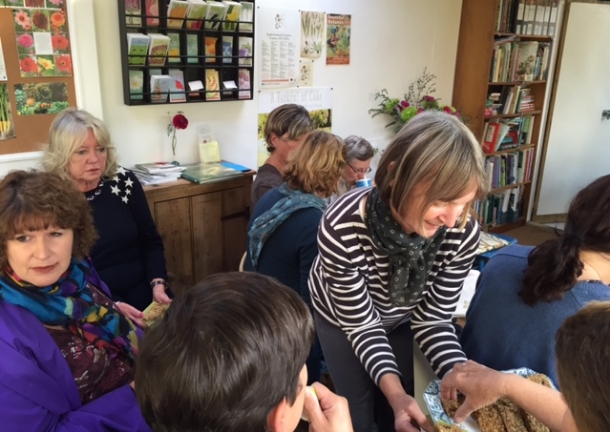
Now in case you’re thinking of whizzing up to Norfolk to see Thorncroft for yourself, remember they are Mail Order only (with an excellent brochure, phone now for the 2016 catalogue). They do have some open days, but you’ll need to check their website for these.
